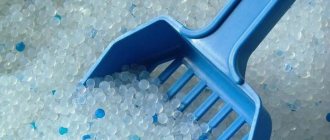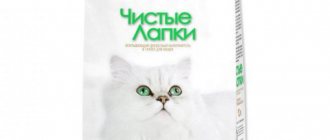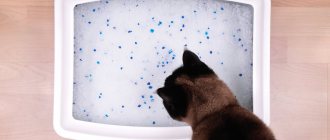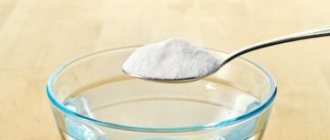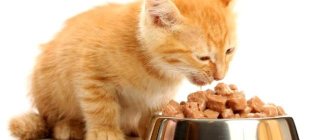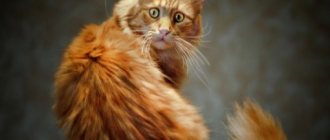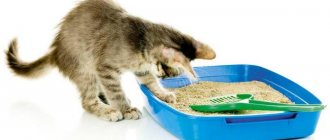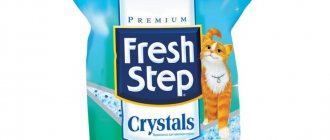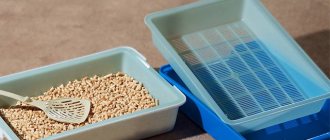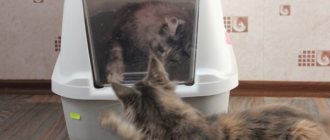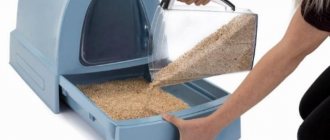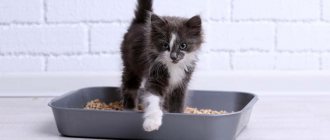If you have a cat in your home, it’s time to think about creating the right conditions for keeping it. In addition to food and a place to sleep, your pet needs a toilet. In apartments and houses, special trays with fillers are successfully used to solve the issue of hygiene and maintain cleanliness in the living space. The store offers a large selection of these compounds, distinguished by different criteria.
In this article we will look at how to choose the right litter for a cat litter box, a description of litter options, their positive and negative sides.
Which cat litter is best to choose?
In earlier times, boxes and other containers filled with sand or paper were used to create a litter box for a domestic cat. However, these compounds did not cope with their task very successfully, required constant replacement and spread the unpleasant smell of cat urine.
To eliminate all the disadvantages of the available “filler”, manufacturers of pet products began to produce special formulations that imitate the natural environment. Artificial litters are well accepted by cats and effectively absorb the smell of feces, keeping the house clean and hygienic.
The assortment includes different types of fillers. Let's take a closer look and determine which composition is best to choose for the cat's litter box.
Absorbent cat litter
The absorbent mineral filler does not change its structure after use and quickly absorbs liquid. Made from natural raw materials that are safe for animals. The composition may include sawdust, corn, pulp and special types of clay. To improve the characteristics of the filler, some manufacturers add activated carbon, soda or silver ions to the base composition.
Popular types of absorbent filler:
- FRESH STEP triple odor protection;
- HOMECAT without additives;
- Tail;
- Zoonic;
- Barsik effect/standard/alpine freshness, etc.
pros
Absorbent litter for the tray has its advantages.
Pros:
- absorbs odor well;
- does not require regular replacement;
- affordable price.
This composition is chosen by owners who have several cats in the house.
Minuses
You can replace the litter once every 7-10 days, but some cats refuse to go to the toilet again, even if the litter is only partially soiled. No obvious deficiencies in the composition were identified.
Clumping filler
Clumping litter is the most popular granular composition made from a clay material with excellent moisture absorption properties. The main composition may include wood, paper, various fragrances and some substances that change the color of the granules after contact with urine.
Popular brands of clumping litter:
- HOMECAT standard, ecoline, etc.;
- NEO LOO LIFE (waste can be flushed down the drain);
- CAT'S BEST SMART PELLETS (clumping wood composition).
pros
Let's look at the advantages of clumping cat litter.
Advantages of the composition:
- absorbs the unpleasant odor of feces well;
- environmentally friendly material is absolutely safe for cats;
- can be used for small kittens;
- convenient cleaning with economical consumption of granules.
Minuses
Disadvantages: Requires daily cleaning of the tray. After going to the cat's toilet, the owner needs to remove the crumpled granules with a special spatula. If you don't do this cleaning, she will spread wet, crumpled granules around the house with her paws.
Not suitable for owners with several cats in the house.
What type of cat litter is best for kittens?
To understand which fillers should be preferred and which ones should not, and why it is worth doing this, the easiest way is to consider all existing types and highlight their main advantages and inconsistencies with the above requirements.
Woody
Despite its enormous popularity, primarily due to its low cost, universal wood litter is not suitable for kittens - its granules are too large, so it will simply be uncomfortable for the owner of small paws. In addition, they make a very loud noise on the plastic tray, which also creates inconvenience.
However, in other respects it is almost ideal, since wood is an environmentally friendly material that, when properly processed, does not form dust and absorbs perfectly. Therefore, there are special wood litters for kittens with small granules on sale, and they can be safely recommended.
Corn
In terms of its basic properties, corn filler is very similar to wood filler, but does not have its main disadvantage - it does not rattle along the bottom of the tray, but only rustles a little. Moreover, the granules are absolutely safe, even if the kitten swallows a small piece. It costs only a little more than wood, but is much less common on sale. But even despite this small drawback, corn fiber litter can be considered the ideal choice for litter box training for kittens.
Mineral
The mineral filler looks like small gray pebbles, and from this alone one can judge its main disadvantages: it will be uncomfortable for soft pads to stand on such a bedding, and if they get into the esophagus, they can cause serious harm. Before the cat grows up, it is better to stop using this type.
Bentonite (clay)
Clay differs from mineral in the size and shape of the granules - they are usually small, reminiscent of the natural “natural filler” - sand. But one important quality makes it unsuitable for use in this case - the granules stick together when wet, which can cause obstruction of the digestive system. Accordingly, it is better to postpone filling the tray with bentonite filler until later, when the kitten begins to understand that the toilet is not made for playing, and nothing edible can be found in it.
Silica gel
Silica gel is one of the most convenient and hygienic options for regular use. It holds odors perfectly, has excellent absorbency and does not require replacement for weeks. However, in the case of kittens, its use is highly not recommended. Firstly, it rustles in the tray and hisses when wet, which can create discomfort. And secondly, getting it into the stomach is highly discouraged, although it is not fatal. Thus, for adult animals this is practically option No. 1, but it is better not to pour it into a kitten’s tray.
Wood filler
Wood filler is created from sawdust compressed into pellets. The contents of the tray can be flushed down the drain. Environmentally friendly composition for animals.
Popular brands of wood filler:
- CAT'S BEST ORIGINAL/ SMART PELLETS / UNIVERSAL;
- HAPPY PET;
- HOMECAT standard/green tea, etc.;
- Tail;
- NEO LOO LIFE.
pros
Let's look at the advantages of wood fillers.
Advantages of the composition:
- ecological natural material;
- well accepted by cats;
- suitable for small kittens;
- complete replacement of the filler – once every 5-7 days;
- can be flushed down the drain.
Minuses
Disadvantages:
- small particles can be carried throughout the house;
- does not absorb urine odor particularly effectively;
- Daily cleaning of the tray is required.
Silica gel filler
Silica gel cat litter is made from a natural component - silica, processed using special technology. A product with zero humidity and a highly porous structure effectively absorbs large volumes of liquid.
Popular brands of silica gel filler:
- FRESH STEP CRYSTALS;
- FLAMINGO SILICA CAT LITTER;
- MIMI LITTER;
- CC Cat;
- Khvostun et al.
pros
Silica gel composition is the most expensive, but at the same time very economical. The filler in the tray is replaced 1-2 times a month. There are other advantages of this filler.
Advantages:
- safe environmentally friendly composition;
- quickly absorbs moisture;
- effectively blocks the unpleasant odor of urine;
- pathogenic bacteria do not multiply in this filler;
- does not spread throughout the house.
Minuses
There are also some disadvantages of silica gel filler. These include the crunchy sound of the granules, which can scare away the cat, and a fairly high price.
Fine Slag - sold in bags in construction stores
The rating of the best substitutes for cat litter is completed by fine slag. This filler is capable of retaining unpleasant odors for some time and absorbs moisture well.
One of the disadvantages is that the animal can take it outside the tray.
But, if we talk about price, fine slag is much more profitable than special filler. It can be bought at any hardware store. A bag of slag will probably last longer than 5 kg of special material, but it will cost several times less.
Of course, when choosing litter, you should also take into account the preference of the animal itself. Not everything suits everyone. But still worth a try.
What other types of fillers are there?
The range of pet products also includes other types of cat litter. Let's look at them.
Types of fillers:
- Mineral – consists of granular minerals with a porous structure. The natural composition absorbs odors and liquid well. Consumption is economical. You can remove spoiled granules using a special spatula. Among the disadvantages: it cannot be washed down the drain; it can emit an unpleasant odor if wet lumps are not removed for a long time.
- Corn is a hypoallergenic composition that has a similar structure to wood filler. Can be used for small kittens. Allowed to be flushed down the drain. Excellent odor neutralization and water absorption. Among the disadvantages: sawdust can be carried around the apartment on the cat’s paws.
- Clay - small granules from certain types of clay, resembling sand in shape. Pros: economical consumption, convenient removal of lumps using a spatula. Disadvantages: the composition is quite dusty, remains on the animal’s paws, cannot be flushed down the toilet.
The best option for cats is a litter with a good structure that does not injure the paws or pollute the fur. The composition should have a natural odor, not contain toxic or allergenic elements and not create unnecessary garbage in the apartment.
Litter tray for cats: which one to choose
Clumping litters come in different sizes: some have larger grains, others have smaller grains. The caliber is written on the packaging. If the sand is made up of very large pieces, it can leak urine to the bottom and clump poorly. Therefore, it is better to choose a smaller caliber. Although it still depends on the manufacturer: you need to try several brands and settle on the most suitable one.
Tails love this type of litter the most: it looks like earth, so cats happily dig holes and bury all their stuff.
But this type of filler also has some disadvantages: if the cat likes to dig too much, then the skin on the paw pads may become a little rougher.
In addition, sometimes kittens play with this filler and eat it. If you see that this problem has become serious, then it is better, at least temporarily, to change the type of filler to a more environmentally friendly one, because Eating clumping can result in intestinal obstruction.
Another caveat is that when the clay mixture is scattered and dug, it raises a cloud of dust, to which the cat may be allergic. Monitor your pet: if he shows signs of illness, such as watery eyes, try changing the litter and see if the symptoms go away.
On “Rozetka” (for Ukraine)
On Yandex Market (for Russia)
Tray with wood filling
Wooden logs cannot be classified as the most hygienic, comfortable and loved by cats, but they are the most environmentally friendly type. It consists of wood blocks - compressed sawdust pellets. The logs smell pleasant, do not raise dust when poured, and do not cause allergies.
But the filler also has disadvantages: when moisture gets on them, logs of wood do not clump together, but, on the contrary, disintegrate into sawdust, so cleaning a toilet with wood filler is quite inconvenient. We recommend using wood filler only with a tray with a mesh (grid), so that all the logs that have broken down into sawdust seep through the grate into the tray, from where you remove them.
Also, wood fillers occasionally contain random sharp pieces of wood, and this is undoubtedly another disadvantage.
The advantage of wood filler is its low price and widespread availability. According to these parameters, it competes with clay.
On “Rozetka” (for Ukraine)
On Yandex Market (for Russia)
Silica gel filler
Silica gel filler is a relative newcomer to the market. It is an artificially created white crystals of silica gel formed from silicic acids. These crystals absorb moisture perfectly, they don’t even need to clump. This is how they differ from absorbent filler. Silica gel retains the smell very well. In everyday life, we deal with this substance when we buy, for example, shoes: the package usually contains a bag of balls. This is silica gel.
This mixture is available in pet stores and online stores, but is not always available in supermarkets. The packaging costs several times more than a bag of clumping litter, but it is more economical: 5 kg is enough for 1 month for one cat.
The disadvantages of the filler are the high price, the less love of cats for litter boxes with silica gel: it hisses a little when it gets wet, which is scary, and besides, silica gel does not look like earth. There is also a danger if it enters the gastrointestinal tract. The fact is that if silica gel gets into the stomach and intestines in large quantities, it absorbs all the moisture, resulting in blockage. Therefore, this type of litter is categorically not recommended for kittens who like to play in the tray. There are numerous cases where animals died.
On “Rozetka” (for Ukraine)
On Yandex Market (for Russia)
Zeolite filler
Zeolite is a volcanic substance and an excellent adsorbent, having a porous structure into which liquid and odor are locked and from which moisture evaporation and, consequently, aromas do not spread. Zeolite filler is a mineral filler. Until recently, it was difficult for us to find it, but now there are already offers.
On “Rozetka” (for Ukraine)
On Yandex Market (for Russia)
Waste grain and paper
One of the most environmentally friendly, along with wood, but at the same time the most unpopular, is a toilet based on recycled grain or paper. Its structure is loose, and when it comes into contact with urine, it becomes even looser and does not retain odors at all, so the contents of the toilet will have to be changed very often.
The exception is corn fillers, which perfectly contain odors, reliably absorb moisture and are completely environmentally friendly. The only downside to this type of litter is its lightness: because of this, cats that rake especially hard with their paws can scoop out grains and paper onto the floor. It is also worth noting that corn filler is still quite difficult to find in our latitudes.
On “Rozetka” (for Ukraine)
On Yandex Market (for Russia)
Quartz fillers
They are absorbent porous granules made of natural quartz sand, purified chalk and minerals. They do not generate dust and have no odor - these are their advantages. They are considered quite economical. Such fillers are poured into the tray in a layer of approximately 5 cm. Only solid feces need to be removed daily. Everything else changes entirely once every 1-2 weeks.
On “Rozetka” (for Ukraine)
On Yandex Market (for Russia)
Soy filler
Made from compressed soy fibers. It is considered an environmentally friendly material and safe to eat. Able to clump upon contact with liquid and retain odor. Doesn't generate dust and doesn't stick to paws.
On “Rozetka” (for Ukraine)
On Yandex Market (for Russia)
Double layer filler
Recently, it has become possible to purchase two-layer fillers, consisting of two “floors” - wood and mineral. These are fillers for disposable cardboard toilets, which are thrown away after contamination.
The mixture is poured into a double plastic tray, which is installed in a cardboard box. Opal-cristabolite granules are poured into a plastic tray with slots at the bottom, and pine shavings are poured into a cardboard tray at the bottom. Moisture passes through the cristabolite and settles in the lower tray in pine shavings. Pine shavings absorb moisture and odor, killing urine bacteria. And the cristobalite sorbent from the top tray locks in the smell, preventing it from evaporating. As the container fills with urine, it is not cleaned, but the bottom tray is simply taken and thrown away, replaced by another box and new pine shavings are poured in. The feces from the upper floor are removed with a dustpan.
